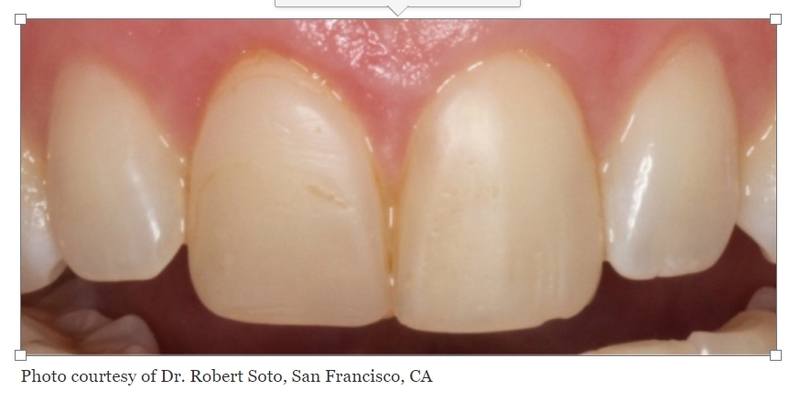
Dental bonding is a popular section of cosmetic dentistry that uses tooth-colored resin to improve the appearance of teeth; the good news is that your composite dental bonding is generally resistant to stains. However, certain substances like coffee, tea, red wine, and tobacco can potentially cause discoloration over time to cause a dental bonding stain.
To maintain the beauty of your composite dental bonding, it’s good to practice oral hygiene, limit stain-causing foods, and regularly visit your dentist to maintain the teeth and gum health.

Does Dental Bonding Stain?
Dental bonding includes the application of a tooth-colored resin material to the teeth, which is then solidified using a special light.
Composite dental bonding can fix several issues like chipped or cracked teeth, gaps between teeth, and even tooth color or shape alterations can be addressed. However, a common concern is whether dental bonding is susceptible to staining over time. Read on to understand dental bonding benefits and its tendency of staining.
Understanding the Nature of Dental Bonding
Dental bonding is a composite resin material that is applied to the teeth and then carefully shaped and polished to match the natural teeth. This material is stain-resistant, which means it is less likely to become discolored compared to natural teeth. However, it is important to note that dental bonding is not completely immune to staining. While it is more resistant to stains than natural teeth, it can still be affected by certain factors.
It is important to take good care of your dental bonding to maintain its appearance and prevent staining. This includes practicing good oral hygiene, avoiding foods and beverages that can stain the teeth, and regular visits to the dentist for professional cleanings and check-ups. By following these measures, you can help ensure that your dental bonding remains stain-free for a longer period of time.
Factors That Can Cause Staining
Dental bonding is generally resistant to staining, but certain factors can cause it to become discolored over time.
- Staining substances like coffee, tea, red wine, and tobacco can adhere to the bonding material and cause discoloration.
- Poor oral hygiene, with plaque and tartar build-up, can also contribute to staining.
- Dental bonding is more prone to staining compared to porcelain veneers, which are made from a stronger and more stain-resistant material.
- Despite its susceptibility to staining, dental bonding remains a popular and affordable option for many individuals seeking less invasive cosmetic dental treatments.
Preventing Staining of Dental Bonding
While dental bonding can become stained over time, there are steps you can take to prevent this from happening and maintain the appearance of your bonded teeth. Here are some tips to help you prevent staining:
- Practice good oral hygiene by brushing your teeth twice a day and flossing daily.
- Avoid consuming staining substances such as coffee, tea, red wine, and tobacco.
- If you do consume these substances, rinse your mouth with water or brush your teeth afterwards to minimize staining.
- Visit your dentist regularly for professional cleanings and check-ups.
- Avoid biting or chewing on hard objects, as this can cause the bonding material to chip or break, making it more susceptible to staining.
By following these tips, you can help ensure that your dental bonding remains stain-free and maintains its natural appearance for a longer period of time.
The Benefits of Dental Bonding
Despite the potential for staining, dental bonding offers several benefits that make it a popular choice for many individuals. Some of the benefits include:
- It is a quick and relatively painless procedure.
- It is less expensive compared to other cosmetic dental treatments.
- It can be completed in a single visit to the dentist.
- It requires minimal removal of tooth structure.
- It can be used to fix a variety of dental issues, including chips, cracks, and gaps.
Overall, composite dental bonding can be a great option for individuals who want to improve the appearance of their teeth without undergoing more invasive and expensive procedures. With proper care and maintenance, dental bonding can provide you with a beautiful smile that lasts for years to come.
Key Takeaways: Does Dental Bonding Stain?
- Dental bonding can get stained over time due to factors like smoking and consuming certain foods and drinks.
- Regular brushing and flossing can help prevent staining on dental bonding.
- Avoiding tobacco products and limiting coffee, tea, and red wine intake can also help minimize staining.
- Professional cleanings and maintenance by a dentist can help keep dental bonding looking fresh and stain-free.
- If dental bonding does become stained, it can usually be polished or repaired by a dentist.
Frequently Asked Questions
What is dental bonding?
Dental bonding is a cosmetic procedure using tooth-colored resin to repair chips, cracks, and gaps, offering a cost-effective way to improve smile aesthetics. However, it may not be as strong as veneers or crowns and requires more maintenance. Dental bonding can stain over time due to its porous nature, absorbing pigments from foods, drinks, and smoking. To minimize staining, avoid or limit consumption of staining substances and maintain good oral hygiene. Dentists can potentially polish or repair stained bonding.
How long does dental bonding last?
The lifespan of dental bonding depends on factors like its location, oral hygiene, and lifestyle. On average, it lasts 5 to 10 years with proper care. Dental bonding is less durable than veneers or crowns and can chip or break from biting hard objects or teeth grinding. Regular dental check-ups allow dentists to monitor and recommend any needed repairs or replacements.
Is dental bonding reversible?
Dental bonding is reversible and can be easily removed without harming the underlying tooth structure. Unlike veneers or crowns, it offers a conservative option for smile enhancement. If dissatisfied with the results or if damage occurs, your dentist can remove the bonding material and discuss alternative treatments.
Can dental bonding be used to fix all dental imperfections?
“Dental bonding is a versatile procedure to fix dental imperfections like chipped teeth, gaps, and stains. However, for severe issues, veneers or crowns might be suggested. Consult your dentist for the best solution.
How to remove stains from composite bonding
Final Summary: Does Dental Bonding Stain?
Dental bonding can develop stains over time, but proper care can prevent this. Regular oral hygiene, like brushing and flossing, removes plaque and food particles that lead to staining. Avoiding stain-causing substances like coffee and tobacco helps maintain the appearance. Regular dental check-ups and cleanings identify potential issues early on and remove stubborn stains. Dentists may suggest touch-ups or replacements when needed. By following these guidelines, dental bonding can enhance your smile for years, providing both aesthetic and confidence benefits.
Call or Book appointment online
:Ace Dental Care Alpharetta office: 678-562-1555 - Book Now
Ace Dental Care Norcross office: 770-806-1255 - Book Now
Disclaimer
This blog post was generated by artificial intelligence. The content of this post may not be accurate or complete, and should not be relied upon as a substitute for professional advice. If you have any questions about the content of this post, please contact us.
We are constantly working to improve the accuracy and quality of our AI-generated content. However, there may still be errors or inaccuracies. We apologize for any inconvenience this may cause.





